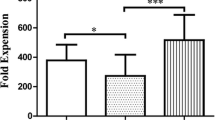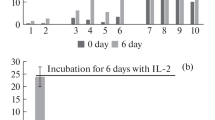Summary
Employing serum-free media, human peripheral blood mononuclear cells, and purified recombinant interleukin-2 (IL-2), conditions were observed in which the development of IL-2-driven cytotoxic activity was suppressed. The cytotoxic activity of such IL-2-generated lymphokine activated killing (LAK) was tested against natural killer-resistant cultured tumor cells (Daudi, Raji, and a glioma). LAK generation was inhibited by addition of some normal sera, normal platelets, or some tumor cells. Because recent reports have indicated that transforming growth factor-beta (TGF-beta)-like factors are often secreted by tumors and the acidic alpha granules of platelets and can be present in sera, we tested the effect of purified human TGF-beta on the activation of LAK. Our results indicated that TGF-beta is very suppressive for LAK induction, and can completely prevent both the IL-2-driven proliferation and cytotoxicity at concentrations as low as 5 ng/ml. Titrations of IL-2 and of TGF-beta indicated that the suppression is dose-dependent and can be avoided by employing higher levels of IL-2. It was also found that the suppressive effect of TGF-beta can be overcome by washing suppressed cell populations and further culture in low levels of IL-2. Collectively, these data indicate that TGF-beta can be a potent inhibitor of LAK generation under standard activation conditions, but that this effect is regulated by the relative level of IL-2 and may be overcome and/or reversed in vitro.
Similar content being viewed by others
References
Anzano MA, Roberts AB, Smit JM, Sporn MB, DeLaco JE (1983) Sacroma growth factor from conditioned medium of virally transformed cells is composed of both type a and type b transforming growth factors. Proc Natl Acad Sci USA 80:6264
Anzano MA, Roberts AB, DeLaco JE, Wakefield LM, Assoian RK, Roche NS, Smith JM, Lazarus JE, Sporn MB (1985) Increased secretion of type beta transforming growth factor accompanies viral transformation of cells. Mol Cell Biol 5:242
Assoian RK, Komoriya A, Meyers CA, Sporn MB (1983) Transforming growth factor-beta in human platelets: identification of major storage site, purification, and characterization. J Biol Chem 258:7155
Brooks WM, Netsky MG, Normansell DE, Horwitz DA (1972) Depressed cell-mediated immunity in patients with primary intracranial tumors: Characterization of a humoral immunosuppressive factor. J Exp Med 136:1631
Childs CB, Proper JA, Tucker RF, Moses HL (1982) Serum contains a platelet-derived transforming growth factor. Proc Natl Acad Sci USA 79:5312
Damle NK, Doyle LV, Bradley EC (1986) Interleukin-2 activated killer cells are derived from phenotypically heterogeneous precursors. J Immunol 137:2814
Derynck R, Jarret JA, Chen EY, Eaton DH, Bell JR, Assoian RK, Roberts AB, Sporn MB, Goeddel DV (1985) Human transforming growth factor-beta complementary DNA sequence and expression in normal and transformed cells. Nature 316:701
Ebert EC, Roberts AI, O'Connel SM, Robertson FM, Nagase H (1987) Characterization of an immunosuppressive factor derived from colon cancer cells. J Immunol 138:2161
Espevik T, Figari IS, Shalaby MR, Lackides GA, Lewis AD, Shepard HM, Paladino MA (1987) Inhibition of cytokine production by cyclosporine A and transforming growth factor-beta. J Exp Med 166:571
Grimm EA (1987) Human lymphokine-activated killer cells (LAK cells) as a potential immunotherapeutic modality. Biochim Biophys Acta 865:26
Grimm EA, Mazumder A, Zhang HZ, Rosenberg SA (1982) Lymphokine-activated killer cell phenomenon. Lysis of natural killer resistant fresh solid tumor cells by interleukin-2 activated autologous human peripheral blood lymphocytes. J Exp Med 155:1823
Grimm EA, Robb RJ, Roth JA, Neckers LM, Lachman L, Wilson DJ, Rosenberg SA (1983) The lymphokine activated killer cell phenomenon. III. Evidence that IL-2 alone is sufficient for direct activation of PBL into LAK. J Exp Med 158:1356
Grimm EA, Muul LM, Wilson DJ (1985) Cyclosporine and hydrocortisone exert differential inhibitory effects on activation of human cytotoxic lymphocytes by recombinant IL-2 versus allospecific CTL. Transplantation 39:537
Grimm EA, Owen-Schaub LB, Loudon WG, Yagita M (1988) Lymphokine-activated killer cells: Induction and function. Cytotoxic T cells: biology and relevance to disease. Ann NY Acad Sci (in press)
Hellstrom KE, Hellstrom I (1979) Enhancement of tumor outgrowth by tumor-associated blocking factors. Int J Cancer 23:336
Itoh K, Tilden AB, Balch CM (1985) Role of interleukin-2 and a serum suppressive factor in the induction of activated killer cells cytotoxic for autologous human melanoma cells. Cancer Res 45:3173
Jacobs SK, Kornblith PL, Wilson DJ, Grimm EA (1986) In vitro killing of human glioblastoma by interleukin-2 activated autologous lymphocytes. J Neurosurg 64:114
Kehrl JR, Roberts AB, Wakefield LM, Jakowlew S, Sporn MB, Fauci AS (1986) Transforming growth factor-beta is an important immunomodulatory protein for human B lymphocytes. J Immunol 137:3855
Kehr JH, Wakefield LM, Roberts AB, Jakoelew S, Alvarez-Mon M, Derynk R, Sport MB, Fauci AS (1986) Production of transforming growth factor-beta by human T lymphocytes and its potential role in the regulation of T cell growth. J Exp Med 163:1037
Kikuchi K, Neuwelt EA (1983) Presence of immunosuppressive factors in braintumor cyst fluid. J Neurosurg 59:790
Lotze MT, Chang AE, Seipp CA, Simpson C, Vetto JT, Rosenberg SA (1986) High dose recombinant interleukin-2 in the treatment of patients with disseminated cancer: Responses, treatment related morbidity, and histologic findings. J Am Med Assoc 256:3117
Miescher S, Whiteside TL, Carrel S, von Fliedner V (1986) Functional properties of tumor infiltrating and blood lymphocytes in patients with solid tumors: effects of tumor cells and their supernatants on proliferative responses of lymphocytes. J Immunol 136:1899
Ortaldo JR, Mason A, Overton R (1986) Lymphokine-activated killer cells. Analysis of progenitors and effectors. J Exp. Med 1674:1193
Owen-Schaub LB, Loudon WG, Yagita M, Grimm EA (1988) Functional differentiation of human lymphokine-activated killing (LAK) is distinct from expansion and involves dissimilar interleukin-2. Receptors Cell Immunol 111:235
Phillips JH, Lanier LL (1986) Dissection of the lymphokine activated killer cell phenomenon. Relative contribution of peripheral blood natural killer cells and T lymphocytes to cytolysis. J Exp Med 164:814
Roberts AB, Anzano MA, Lamb LC, Smith JM, Sporn MB (1981) New class of transforming growth factor: isolation from non-neoplastic tissue. Proc Natl Acad Sci USA 78:5339
Rook AH, Kehrl LM, Wakefield AB, Roberts MB, Sportn D, Burlington B, Lane HC, Fauci AS (1986) Effects of transforming growth factor-beta on the functions of natural killer cell: Depressed cytolytic activity and blunting of interferon responsiveness. J Immunol 136:3916
Roth JA, Grimm EA, Gupta RK, Ames RS (1982) Immunoregulatory factors derived from human tumors: I. Immunologic and biochemical characterization of factors that suppress lymphocyte proliferative and cytotoxic in vitro. J Immunol 128:1975
Rosenberg SA, Grimm EA, McGrogan M, Doyle M, Kawasaki E, Koths KK, Mark DF (1984) Biological activity of recombinant human interleukin-2 producted in E58–1cherichia coli. Science 233:1412
Rosenberg SA, Lotze MT, Muul LM, Leitman S, Chang AE, Ettinghausen SE, Matory YL, Skibber JM, Reichert CM (1985) Observations on the systemic administration of autologous lymphokine-activated killer cells and rcombinant interleukin-2 to patients with metastatic cancer. N Engl J Med 303:1485
Rubin LA, Kurman CC, Fritz ME, Biddison WE, Boutin B, Yarchoan R, Nelson DL (1985) Soluble interleukin-2 receptors are released from activated human lymphoid cells in vitro. J Immunol 135:3172
Sporn MB, Roberts AB, Wakefield LM, Assoian RK (1986) Transforming growth factor-beta: Biological function and chemical structure. Science 233:532
Tsudo M, Goldman CK, Bongiovanni KF, Chan WC, Winton EF, Yagita M, Grimm EA, Waldmann TA (1987) The p75 peptide is the receptor for interleukin-2 expressed on large granular lymphocytes and is responsible for the interleukin-2 activation of these cells. Proc Natl Acad Sci USA 84:5394
Wrann M, Bodmer S, deMartin R, Siepl C, Hofer-Warbinek R, Frei K, Hofer E, Fontana A (1987) T cell suppressor factor from human glioblastoma cells is a 12.5 Kd protein closely related to transforming growth factor-beta. EMBO J 6:1633
Author information
Authors and Affiliations
Rights and permissions
About this article
Cite this article
Grimm, E.A., Crump, W.L., Durett, A. et al. TGF-Beta inhibits the in vitro induction of lymphokine-activated killing activity. Cancer Immunol Immunother 27, 53–58 (1988). https://doi.org/10.1007/BF00205758
Received:
Accepted:
Issue Date:
DOI: https://doi.org/10.1007/BF00205758




